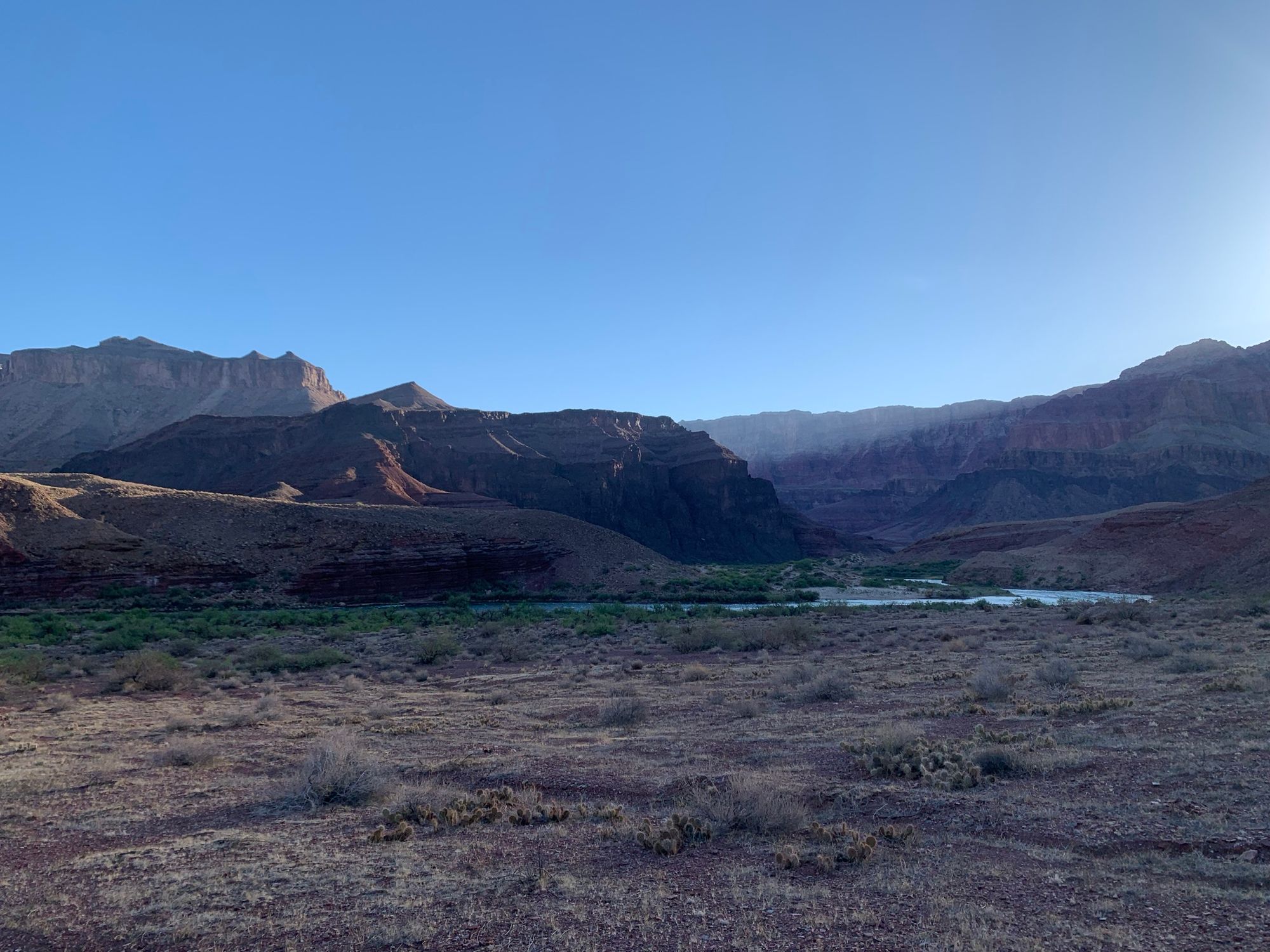Grand Canyon - Escalante Route

Overview
On 5/28/21 Julia Bodiford, a friend, and I began the Escalante Route in the Grand Canyon. We approached the route via Tanner Trail, exiting via the New Hance Trail on 5/30/21. The Escalante Route is considered the most rugged backcountry “trail” in the Grand Canyon National Park, and can be accessed only via Tanner Trail to the east, but can be accessed via the New Hance Trail or the Tonto Trail (via Horseshoe Mesa and Grandview Point) to the west. The route descends to the Colorado River and travels along the river for quite a ways traversing up and down to avoid rugged terrain on the river side before exiting the canyon downriver. The route is almost completely exposed to the sun with the exception of a few beautiful shaded beachside spots where the trail coincides with the Colorado River.
The inner part of the route has some second and third class terrain, with a loose scree slope and a short wall that must be climbed with hands and feet.
I previously hiked the route solo and exited via the Grandview Trail in May 2018.
Weather & Conditions
Late May in the Grand Canyon is considered summer, with inner canyon highs usually at or exceeding 100 Fahrenheit. Sunrise was around 5:20 AM, due to Arizona not observing daylight savings time. We had exceptional cloud cover in the afternoons, which is unusual and quite lucky as we were out late in the day often.
I’d estimate our highs in the 90-95 F range, and our lows around 65-75 F.
Elevation, Mileage, and Timing
Total:
- 3 days
- ~ 27.5 miles (+ 1.2 miles not recorded)
- ~ 7.5 k feet of gain
Day 1 (Strava link):
- 5 hours, 50 minutes
- 8.3 miles
- 403 feet of gain
Day 2 (Strava link):
- 8 hours 53 minutes
- 11.68 miles (+ 0.7 miles not recorded)
- 2.4 k feet of gain
Day 3 (Strava link):
- 8 hours, 30 minutes
- 7.5 miles (+ 0.5 miles not recorded)
- 4.7 k feet of gain
Day 1 descended to the river, day 2 went along the river (up and down), and day 3 climbed back out of the canyon.
Notes and Lessons Learned
- 3k - 3.5k calories per day is fine for a day or two, after that it’s not enough. I’ll make it but with a noticeable decline in energy.
- Gels/gummies/bars can get me through about 6-9 hours and then I start to need “solid” food. Similarly, around 2k - 2.5k calories of these things is about all I can handle.
- I did not take a sleeping bag, but I did take a puffy, and used it at night, along with wearing my clothes that I brought (pants and sun shirt) and this was sufficient. I was a tad chilly one night but did not have my tent rainfly up.
- There were many issues stemming from the partner we chose. They were unprepared and lacked the experience necessary for the trip, and were disagreeable about these shortcomings. Some things I could have done differently to avoid the situation:
- Being more specific about experiences. When qualifications were discussed pre-trip they were embellished and glossed over.
- I should have left more time beforehand to go over their packing list with them. We spent far more time than expected going over gear and helping them organize and purchase needed items, leading me to rush my own packing (and forget my boots in the process- I did the hike in very worn trail runners).
- I have a pre-trip checklist that would have likely uncovered some of these issues and led us to choose a more appropriate route. The checklist was begun but glossed over. I’ll definitely take it more seriously next time and follow it to the letter. A serious discussion should be had about what route would be appropriate for the group. I must follow up on whether someone has actually read the route description they were given (in this case they said they had read it, but had either not read it or not understood it).
- The checklist would have also uncovered that our partner relied on contacts to see. Luckily they had the foresight to bring backup contacts and glasses on their own.
- Some things are very difficult to mitigate. For instance, we discussed pacing and breaks beforehand, deciding that 5 minutes per hour would be appropriate. At one point, almost 20 minutes per hour were necessary, complete with arguments about how the breaks were actually 5 minutes. Uncovering a general lack of experience could have prevented something like this.
- We completed the third day late in the afternoon, and then had an 8.5 hour drive home. We had a brief group discussion, decided to go all the way home, and headed out. We found out later that our partner was not comfortable with the drive but also did not voice this at the time. After some postmortem discussion we decided on the following:
- Shifts should be explicitly discussed when considering a drive that goes well past midnight.
- A backup plan should be considered and discussed before beginning the late drive. What will you do if 11 PM rolls around and no one wants to drive anymore?
- Newer or less experienced party members in general should be explicitly consulted and more care should be given to finding out their comfort level with decisions being made. If new to the group, they could find themselves defaulting to others’ decisions that they aren’t comfortable with.
Photos
Day 1



Day 2





Day 3


